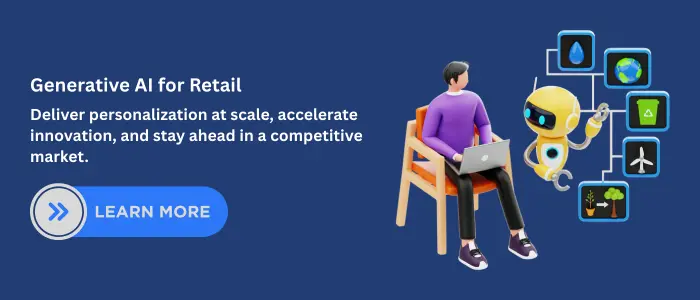Introduction
Generative AI for Retail is rapidly reshaping the way the industry operates, from delivering hyper-personalized shopping experiences to transforming operational workflows. Consequently, retailers are unlocking new revenue streams, achieving measurable cost savings, and enhancing customer satisfaction.
Moreover, unlike traditional automation, Generative AI for Retail creates entirely new outputs based on learned patterns. These include personalized product recommendations, persuasive marketing copy, photorealistic product images, and optimized store layouts. Therefore, businesses can shift from reactive responses to proactive, customer-focused innovation that drives loyalty.
1. The Game-Changing Potential for Retail Growth
To begin with, the economic potential of Generative AI for Retail is extraordinary. According to research, the sector could unlock between $400 billion and $600 billion in added value through AI integration. Consequently, such vast potential requires serious attention from every retailer.

Moreover, the modern retail market is more competitive and faster-moving than ever. Because customers now demand seamless personalization across channels, businesses must respond quickly to changing behaviors. Therefore, Generative AI for Retail offers the scalability, precision, and adaptability required to compete effectively.
In addition, this technology is not a passing trend but a foundational driver of sustainable growth. As a result, businesses that embrace it now will secure a lasting competitive edge, while those that delay risk falling behind more agile rivals.
2. Reducing Costs and Boosting Efficiency with AI

Generative AI for Retail delivers measurable cost reductions across multiple functions. For example, companies have reported lowering customer acquisition expenses by up to 50% through AI-powered personalization. Consequently, support costs have fallen by as much as 30% when AI systems handle common inquiries.
Moreover, because AI automates repetitive tasks, employees can focus on strategic priorities. Therefore, customer service agents can dedicate more time to complex cases, and marketing teams can invest in creative development.
In addition, AI-generated content reduces reliance on large writing teams. As a result, retailers maintain brand consistency while controlling staffing costs. Furthermore, the combination of efficiency and accuracy drives higher profitability.
3. Accelerating Time-to-Market for Products and Campaigns

In addition to reducing costs, Generative AI for Retail accelerates time-to-market dramatically. Consequently, processes that previously took weeks can now be completed in days.
For instance, when a sudden fashion trend emerges, AI can instantly generate product descriptions, visuals, and promotional messaging. As a result, businesses can launch campaigns in time to capitalize on the trend’s peak demand.
Moreover, rapid production enables A/B testing of multiple creative variations. Therefore, marketers can analyze performance in real time and quickly refine campaigns. Ultimately, this agility empowers retailers to capture more opportunities and outpace competitors.
4. Smarter Supply Chain Decisions with Predictive AI

Generative AI for Retail improves supply chain planning through accurate, data-driven forecasting. Consequently, it analyzes sales history, seasonal patterns, and real-time data to predict demand precisely.
Moreover, predictive AI can model “what-if” scenarios to guide decision-making.
For example, it can evaluate the potential impact of launching a new product or running a major discount campaign. As a result, managers can make better-informed choices that reduce waste and optimize inventory.
In addition, real-time forecast updates allow businesses to adapt quickly to market shifts. Therefore, supply chain operations become more resilient, ensuring products remain available when customers want them.
To learn how even smaller enterprises can leverage such technology for better planning and growth, explore our guide on AI for Small Business.
5.Hyper-Personalized Marketing for Every Shopper
One of the most powerful applications of Generative AI for Retail is hyper-personalized marketing. Consequently, by analyzing customer preferences, purchase history, and engagement patterns, AI delivers tailored promotions that increase conversions.

Moreover, dynamic segmentation allows different audiences to receive unique content. For example, value-conscious shoppers may see special discounts, while premium buyers receive luxury product recommendations. As a result, relevance improves and loyalty deepens.
In addition, AI-powered personalization updates in real time as customer behaviors evolve. Therefore, marketing efforts remain timely, impactful, and aligned with shifting interests.
6. AI-Powered Content Creation at Scale

Generative AI for Retail solves the challenge of producing large volumes of consistent, high-quality product content. Consequently, it can instantly create SEO-optimized descriptions that maintain a unified brand voice.
Moreover, AI can tailor content for specific platforms. For instance, detailed descriptions can appear on product pages, while shorter, more engaging versions are posted to social media. As a result, each channel is used to its maximum potential.
In addition, search-optimized product listings help boost rankings, attract more organic traffic, and convert more browsers into buyers. Therefore, AI-generated content enhances both reach and sales performance. To learn more about the technology behind this capability, check out our guide on what is Generative AI.
7.Data-Driven Forecasting for Inventory Success

Effective inventory control is critical in retail, and Generative AI for Retail makes it smarter. Consequently, it analyzes sales data, seasonal trends, and current demand indicators to produce accurate forecasts.
Moreover, AI enables scenario testing. For example, it can simulate how a large promotion would impact stock levels, helping managers prepare restocking strategies. As a result, inventory planning becomes more precise and profitable.
In addition, accurate forecasting prevents stockouts and overstocking, both of which can erode customer trust. Therefore, AI-powered inventory management strengthens overall retail performance.
8.Transforming Customer Service into a Sales Engine

Generative AI for Retail elevates customer service from a reactive support function to an active sales driver. Consequently, AI-powered assistants can instantly answer FAQs, track orders, and process returns.
Moreover, virtual shopping assistants can suggest products, recommend complementary items, and guide customers through the buying journey. As a result, every service interaction becomes an opportunity to increase sales.
In addition, AI learns from each customer interaction, continually improving its recommendations. Therefore, service quality and conversion rates rise together over time.
9. Automating Operations and Strengthening Risk Control
Generative AI for Retail streamlines back-office processes by automating repetitive tasks. Consequently, scheduling, reporting, and data entry require less manual input, freeing staff for higher-value work.
Moreover, AI enhances fraud detection by spotting unusual patterns in transaction data. As a result, retailers can act quickly to prevent losses and protect customer accounts.
In addition, automation improves accuracy and compliance, reducing costly errors. Therefore, operational automation is both a productivity and risk management asset.
10. Empowering Employees with Intelligent Tools

Generative AI for Retail acts as a collaborative partner, enabling employees to work faster and smarter. Consequently, marketers can generate campaign ideas instantly, developers can automate routine coding, and managers can prepare schedules more efficiently.
Moreover, freeing staff from repetitive work boosts creativity and morale. As a result, teams can focus on innovation, strategic initiatives, and customer engagement.
In addition, productivity gains of 5% to 40% are common with AI adoption, directly contributing to stronger business performance. Therefore, empowering employees with AI is a win for both staff and the bottom line.
11. Your Roadmap to Successful AI Adoption
Before integrating Generative AI for Retail, businesses must evaluate readiness. Consequently, this involves assessing data quality, technology infrastructure, and internal capabilities.
Moreover, identifying high-impact, achievable use cases ensures early wins. For example, starting with personalized marketing or automated content creation can generate quick ROI. As a result, confidence in the technology grows across the organization.
In addition, AI integration should connect with core systems like CRM and ERP to ensure access to accurate, complete data. Therefore, output quality and decision-making improve significantly.

12. Scaling Responsibly with Governance and Ethics
Scaling Generative AI for Retail requires careful planning. Consequently, expanding too quickly can lead to inefficiencies, so a phased rollout is advisable.
Moreover, governance policies must guide ethical AI use, validate outputs, and protect customer privacy. Furthermore, regular audits help detect and reduce bias.
In addition, transparency fosters trust. Therefore, retailers who clearly explain how AI enhances customer experiences without compromising privacy gain stronger loyalty.
Conclusion
Generative AI for Retail is now essential for success in today’s competitive market. Consequently, adopting it can reduce costs, deliver personalization at scale, and drive sustainable growth. Moreover, retailers that move quickly will lead the industry, while those that delay risk falling behind.
Therefore, partnering with a skilled AI development company can provide the expertise and solutions needed to implement Generative AI for Retail effectively and achieve long-term success.
Therefore, the smartest time to invest in Generative AI for Retail is now.
FAQ'S
What is generative AI in retail?
Generative AI is technology that creates new content, designs, and recommendations based on data. In retail, it is used for product descriptions, personalized marketing, virtual assistants, and more.
How much value can it generate?
Estimates suggest between two hundred forty billion and six hundred billion dollars in potential value for the retail industry.
What are the top use cases?
They include personalized marketing, content creation, demand forecasting, customer service, operational automation, and employee enablement.
Is scaling AI difficult?
Scaling requires planning, governance, and integration with existing systems. Gradual expansion with clear metrics is the most effective approach.
How can retailers ensure ethical use?
By establishing governance frameworks, conducting audits, maintaining transparency, and safeguarding customer privacy.



















